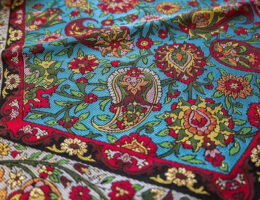IRAN ART EXHIBITION: WHAT IS THE ART OF FILIGREE SEWING?
The art of ornamenting and decorating the surface of fabrics by means of all kinds of traditional decorative sewing is called embroidery which is usually used for fabrics with a simple background and includes all kinds of stitches and knots. Employment of all kinds of embroidery and innovation of new styles in this art and a combination of them has existed in different periods since thousands of years ago.
In Iran, the talent and taste of Iranian artists have been too further than sufficing just to weaving various colorful clothes but has been able to make the background of simple fabrics such as canvas seem colorful and brilliant by sewing all kinds of decorative beads and ornamental threads. Utilization of decorative sewing became more prevalent in the Islamic period, especially from the third century (AH) onwards when the Iranian craftsmen and artists undertook to decorate the veil of Ka’aba with braid threads.

Training Persian Embroidery in Isfahan
IRAN ART EXHIBITION: Traditional embroidering should maintain its proper position with skillful artists, especially in embroidered stalks, and if someone does not understand the difference between a simply embroidered stalks and filigree embroidery, it is better not to mistaken others with wrong training.
Filigree Sewing
Filigree, in fact, is the same threads of silver and gold which is formed like a spring (that is tinsel) and sewn on the cashmere fabric in two types of original and artificial. Finally, the filigreed cashmere fabric is undercoated with a floral or colored cloth proportional to the color of cashmere fabric.






